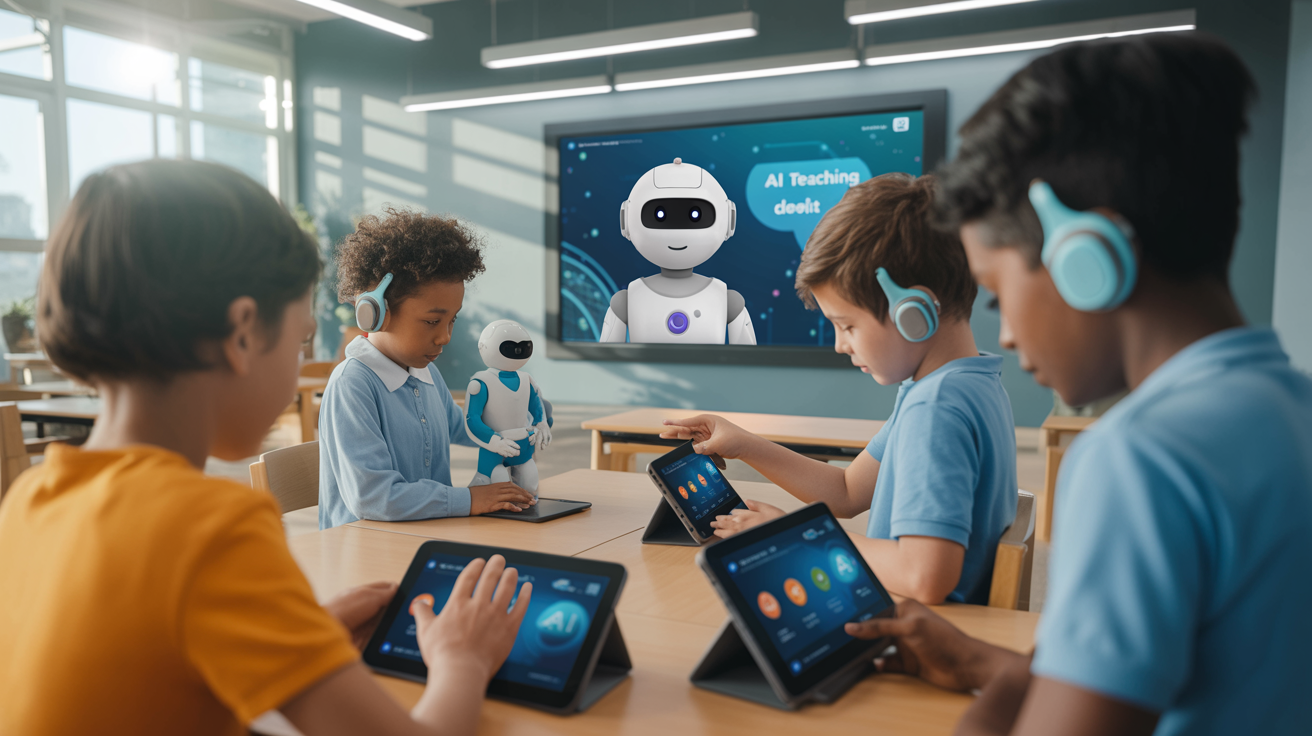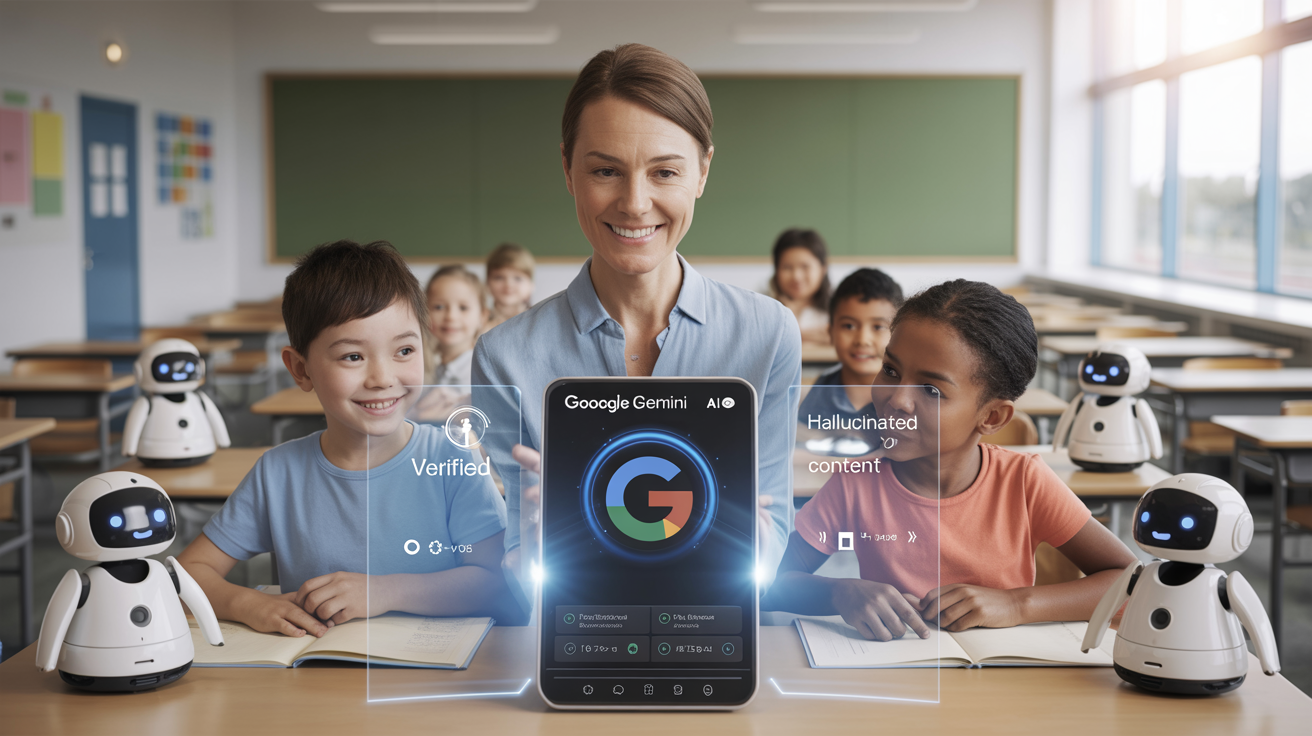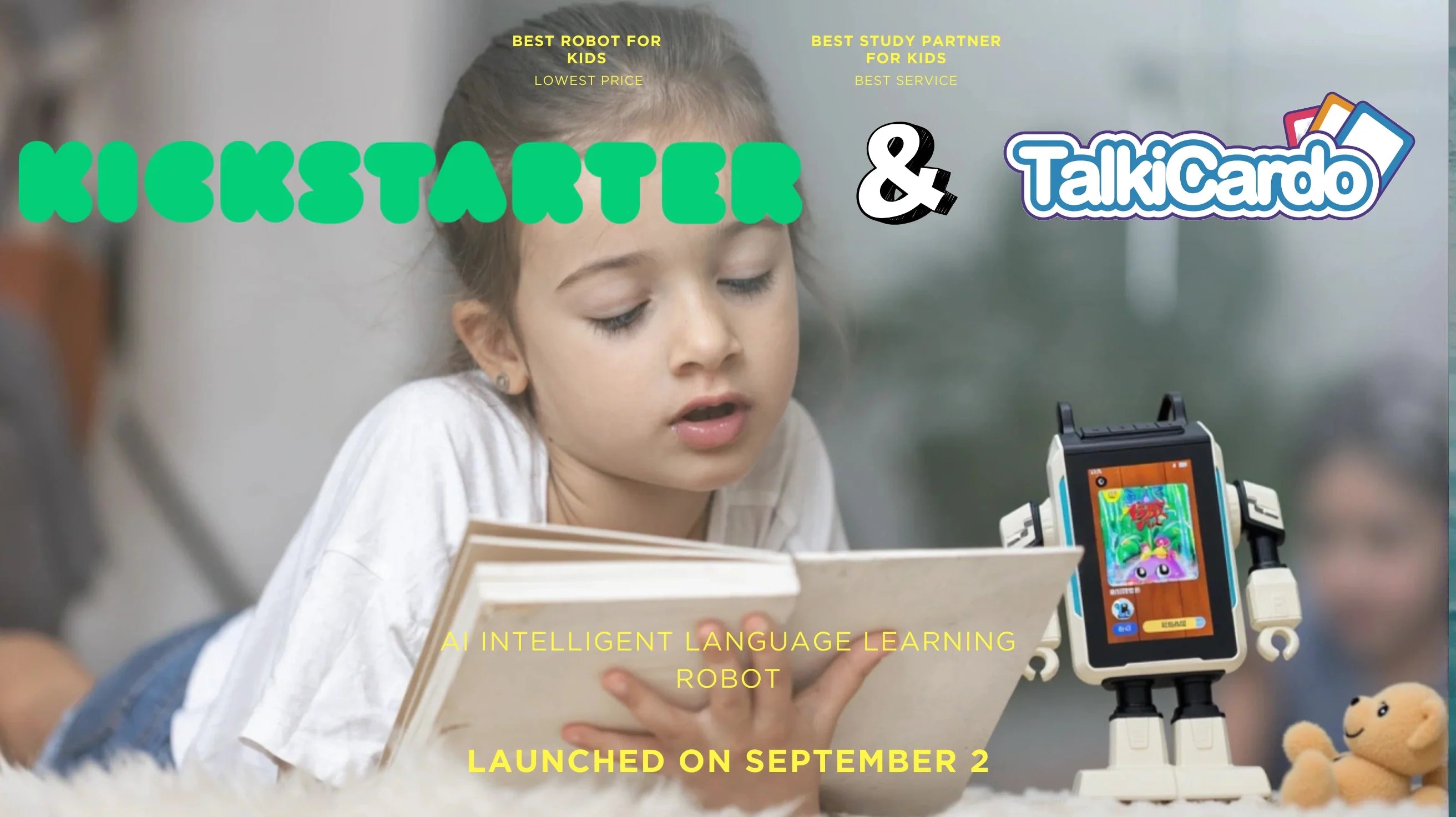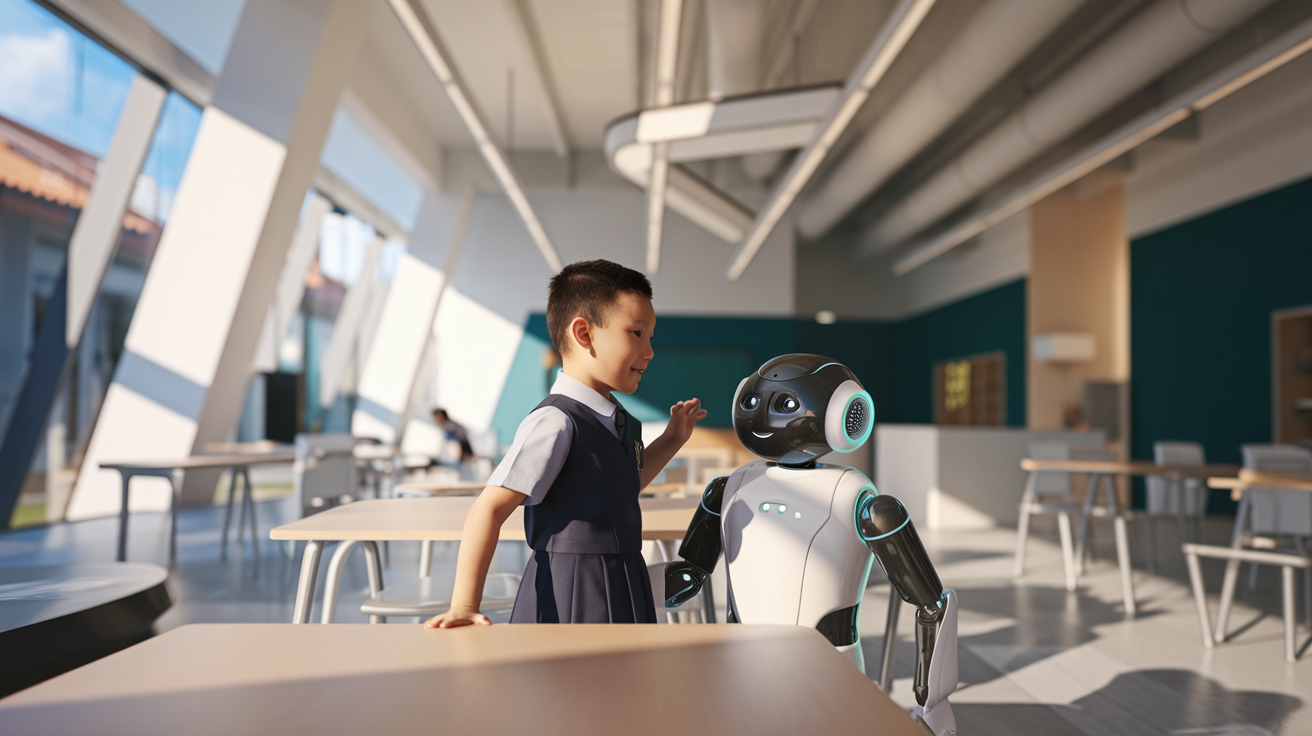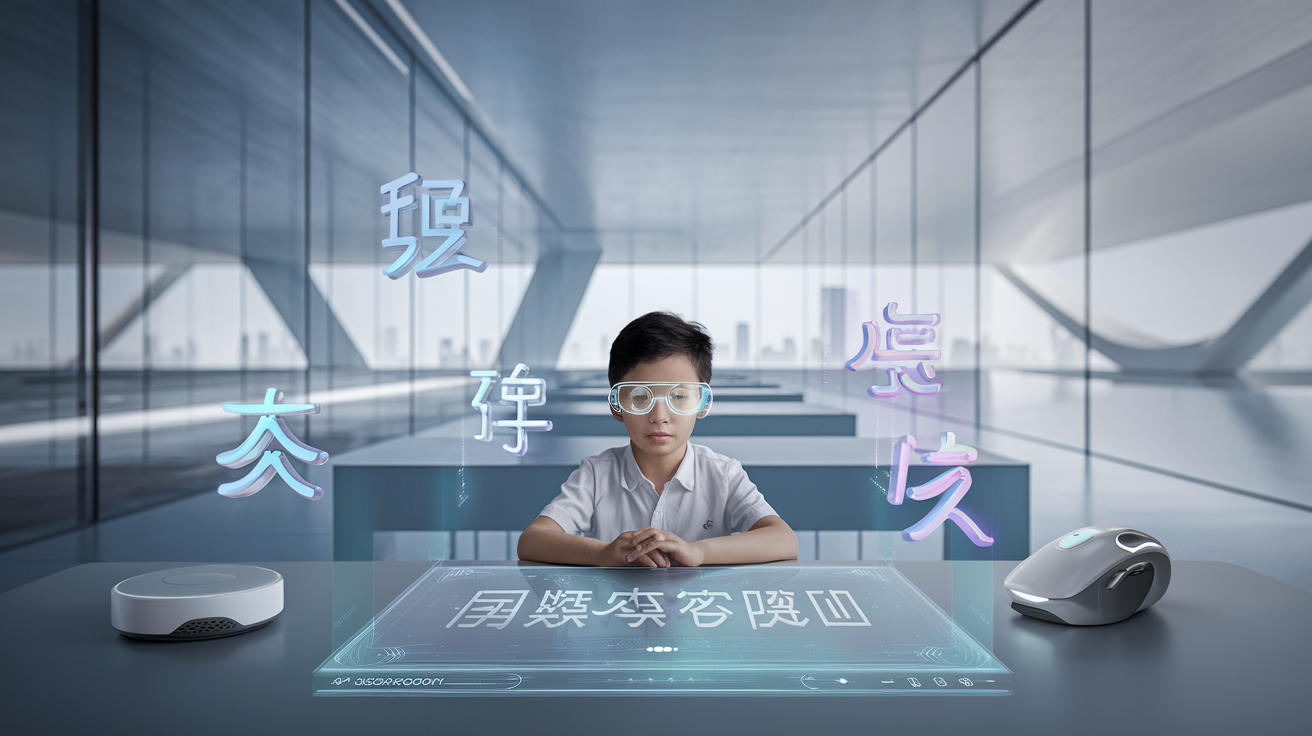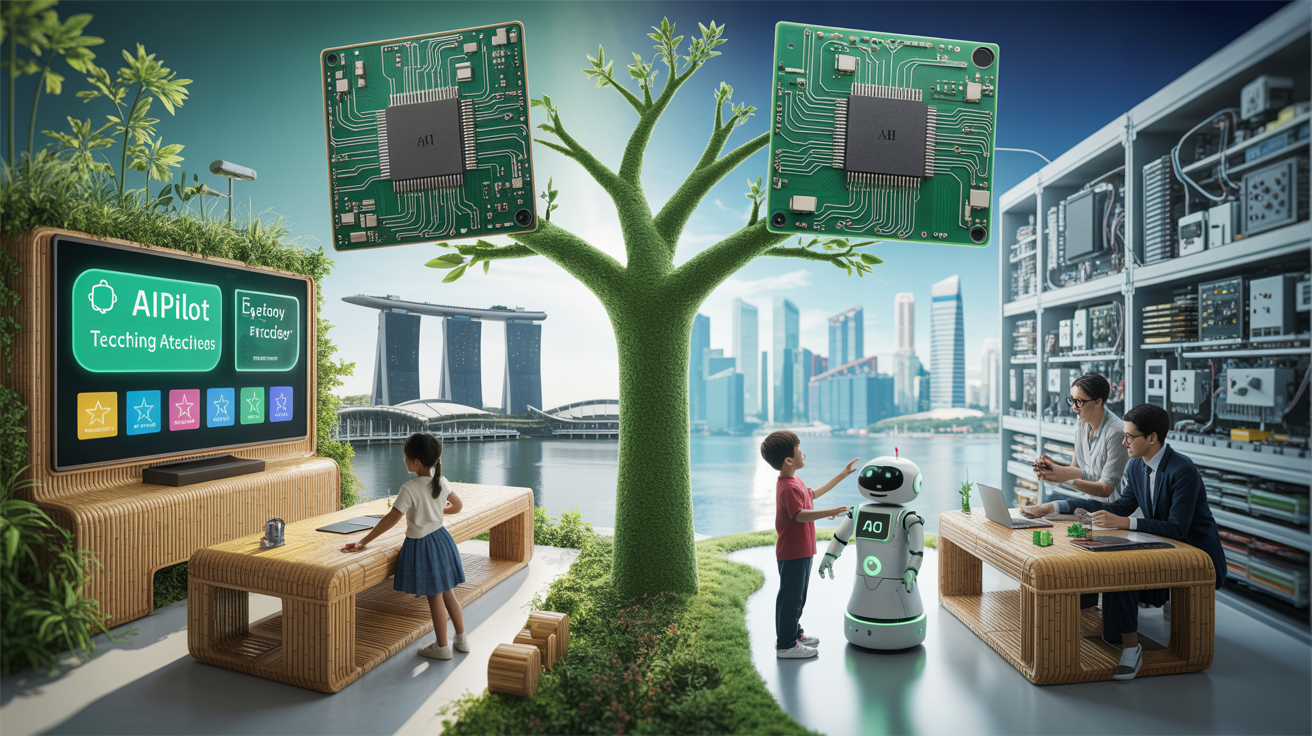
AI Carbon Footprint: Making Greener Hardware Choices in Educational Technology
Posted by Aipilot on
Table Of Contents
- Understanding AI's Carbon Footprint in Education
- The Environmental Impact of AI Hardware in EdTech
- Sustainable Hardware Solutions for AI-Powered Learning
- Energy Efficiency Strategies for Educational AI Devices
- Lifecycle Management and Circular Design Approaches
- AIPILOT's Approach to Sustainable EdTech Innovation
- Future Directions: Balancing Innovation and Sustainability
- Conclusion: Toward a Greener AI-Powered Educational Future
Picture this: a classroom buzzing with AI-powered learning devices, students engaged with smart tutors, and teachers analyzing real-time data to personalize instruction. This educational technology revolution promises unprecedented learning opportunities—but at what environmental cost?
As artificial intelligence transforms education through innovations like AI teaching assistants and language learning platforms, we're facing an important question: How can we balance technological advancement with environmental responsibility?
The carbon footprint of AI systems—particularly in hardware manufacturing, deployment, and operation—presents a significant challenge for the EdTech industry. With AI models requiring increasingly powerful computing resources, educational institutions and technology providers must consider the environmental implications of their digital transformation efforts.
In this article, we'll explore practical approaches to reducing the environmental impact of AI hardware in educational settings, examine sustainable design practices, and highlight how companies like AIPILOT are working to create more eco-friendly AI educational experiences without compromising on quality or effectiveness.
Reducing AI's Carbon Footprint in EdTech
Sustainable Hardware Approaches for Educational Technology
AI-powered learning offers transformative educational experiences, but comes with significant environmental costs. Discover how to balance innovation with sustainability.
The AI Carbon Challenge
- Manufacturing AI hardware components requires significant resources
- Training a single large AI model can emit as much carbon as five cars over their lifetimes
- Educational devices typically see intensive daily use across multiple users
Sustainable Hardware Design
- Biodegradable components and recycled materials
- Modular design for component-level repairs and upgrades
- Edge computing to reduce cloud processing energy requirements
Energy Efficiency Strategies
Adaptive Power Management
Adjust performance based on actual educational needs
Optimized AI Models
Educational-specific models require less computational power
Renewable Energy
Pair AI deployments with renewable energy investments
Lifecycle Management
Design for Disassembly
Enables easier recycling and component recovery
Take-back Programs
Structured pathways for responsible recycling
Second-life Applications
Repurpose hardware for simpler educational tasks
AIPILOT's Sustainable Approach
- Integration of software and hardware solutions for optimized efficiency
- Emotionally durable design that encourages longer-term product relationships
- Energy-efficient AI processing techniques including model compression
- Sustainable packaging and responsible materials sourcing
Future Directions
Neuromorphic Computing
Brain-inspired computing architectures with lower energy requirements
Carbon-aware Computing
AI systems that adjust operation based on carbon intensity of electricity
Creating a Greener AI-Powered Educational Future
By prioritizing sustainable approaches to AI hardware in education, we can ensure that technological advancement serves both our educational goals and our environmental responsibilities.
Explore AIPILOT's Sustainable AI Solutions© AIPILOT - Making AI Education Greener
Understanding AI's Carbon Footprint in Education
When we talk about AI's environmental impact in education, we're addressing multiple interconnected factors. The carbon footprint of AI educational technologies stems from several sources:
The manufacturing process of AI hardware components requires significant resources and energy. From mining rare earth minerals for processors to the production of circuit boards and displays, each step contributes to greenhouse gas emissions. For educational devices like AI language learning robots or smart teaching tools, these manufacturing processes represent a substantial portion of their lifetime carbon footprint.
Additionally, the energy consumption during operation presents ongoing environmental concerns. AI models—especially large language models that power many educational applications—require substantial computational resources. A typical AI teaching assistant running complex natural language processing might consume significantly more energy than traditional educational software.
Training these AI models also demands enormous computational resources. Research from the University of Massachusetts Amherst suggests that training a single large AI model can emit as much carbon as five cars over their lifetimes. While this training often happens before educational deployment, it remains part of the technology's overall environmental impact.
For educational institutions implementing AI solutions, the cumulative effect of multiple AI-powered devices across campuses can substantially increase energy consumption and associated carbon emissions. As schools and universities globally adopt more AI technologies, addressing these environmental concerns becomes increasingly urgent.
The Environmental Impact of AI Hardware in EdTech
Educational technology hardware presents unique sustainability challenges. Unlike some consumer electronics that might be used occasionally, educational devices typically see intensive daily use across multiple users, creating both opportunities and challenges for sustainable design.
The environmental footprint of educational AI hardware extends beyond energy consumption to include resource extraction, manufacturing impacts, and end-of-life disposal concerns. For example, the rare earth elements essential for many AI hardware components face supply constraints and often involve environmentally damaging extraction processes.
Consider a classroom set of AI learning devices: each unit contains processors, memory components, displays, batteries, and various sensors. The environmental impact multiplies when deployed across thousands of classrooms globally. According to the Global E-waste Monitor, educational electronics contribute significantly to the approximately 50 million tons of e-waste generated annually worldwide.
The rapid pace of technological advancement in AI education exacerbates these challenges, as hardware may become outdated before reaching its physical end-of-life. Schools facing budget constraints might continue using older, less energy-efficient AI hardware, creating a tension between resource conservation and educational effectiveness.
However, these challenges also present opportunities for innovation. Educational technology has unique advantages for implementing sustainable practices, including centralized purchasing decisions, predictable usage patterns, and the potential for longer deployment cycles compared to consumer devices.
Sustainable Hardware Solutions for AI-Powered Learning
Creating more sustainable AI educational hardware requires rethinking design approaches from the ground up. Several promising strategies have emerged in recent years:
Material innovation represents one of the most impactful approaches. Biodegradable components, recycled plastics, and sustainably sourced materials can significantly reduce the environmental footprint of educational AI devices. For example, some manufacturers now offer device casings made from post-consumer recycled plastics or plant-based polymers for items like AI learning tablets and smart pens.
Modular design principles allow for component-level repairs and upgrades rather than whole device replacement. This approach can dramatically extend the useful life of educational AI hardware. A modular AI teaching assistant device might allow schools to upgrade only the processor or memory components when needed, rather than replacing the entire unit.
Edge computing architecture reduces reliance on cloud processing by performing more AI computations directly on educational devices. This approach reduces data transmission energy requirements and can provide more reliable operation in schools with limited internet connectivity. For language learning applications, processing basic interactions locally while only sending complex queries to cloud servers can significantly reduce the overall carbon footprint.
Low-power hardware designs specifically optimized for educational AI applications can deliver sufficient performance while consuming significantly less energy. Specialized processors designed explicitly for machine learning operations can be more energy-efficient than general-purpose computing for AI educational tasks like automated essay grading or pronunciation analysis.
Case Example: Smart AI Chat Cards
TalkiCardo Smart AI Chat Cards represent an innovative approach to sustainable educational AI hardware. These physical cards paired with digital AI capabilities demonstrate how thoughtful design can reduce environmental impact while delivering effective learning experiences. By separating the physical interface (durable cards) from the computational components (smartphone or tablet), this solution extends hardware lifespan and reduces electronic waste compared to dedicated single-purpose devices.
Energy Efficiency Strategies for Educational AI Devices
Beyond hardware design, optimizing how AI educational tools consume energy presents significant opportunities for reducing carbon footprint:
Adaptive power management systems can intelligently adjust performance based on actual educational needs rather than running at full capacity continuously. For example, an AI language tutor might reduce processing power during simple vocabulary exercises while allocating more resources for complex conversation practice.
Optimized AI models designed specifically for educational contexts often require less computational power than general-purpose models. By focusing on the specific language patterns and knowledge domains relevant to educational settings, these specialized models can deliver effective learning experiences with lower energy requirements.
Renewable energy integration offers another promising approach. Educational institutions can pair AI technology deployments with renewable energy investments, potentially achieving carbon-neutral operations. Some schools have successfully implemented solar-powered AI learning labs that generate sufficient energy to power their educational technology infrastructure.
Intelligent scheduling of resource-intensive AI operations can also reduce environmental impact. For instance, running batch processing of student assignments during off-peak hours when renewable energy is more abundant, or distributing computational loads across a network of devices to prevent any single unit from operating at maximum power continuously.
Lifecycle Management and Circular Design Approaches
Addressing the environmental impact of AI educational hardware requires considering the entire product lifecycle, from initial design through end-of-life recovery:
Design for disassembly enables easier recycling and component recovery at end-of-life. Educational AI devices designed with easily separable materials and accessible components facilitate more effective recycling processes. This approach might include using standardized screws instead of adhesives, clear material labeling, and avoiding mixed materials that are difficult to separate.
Take-back programs offer structured pathways for educational institutions to return outdated AI hardware to manufacturers for responsible recycling or refurbishment. These programs can recover valuable materials while preventing harmful disposal practices. Some educational technology providers now offer discounts on new purchases when schools return old equipment through official channels.
Second-life applications for educational AI hardware create value beyond initial use cases. For example, AI devices that no longer meet the computational requirements for advanced language learning might be repurposed for simpler educational tasks or donated to schools with less demanding requirements. This approach extends the useful life of hardware while providing educational opportunities to underserved communities.
Circular economy principles applied to educational technology can transform the traditional linear model of production, use, and disposal. By designing for durability, repairability, and material recovery, manufacturers can create more sustainable hardware ecosystems. Some innovative educational technology providers now offer hardware-as-a-service models, where they maintain ownership of physical devices while schools subscribe to the educational services, incentivizing manufacturers to design for longevity and recyclability.
AIPILOT's Approach to Sustainable EdTech Innovation
As a Singapore-based artificial intelligence company specializing in educational technology, AIPILOT demonstrates how AI providers can balance innovation with environmental responsibility:
Integration of software and hardware solutions allows AIPILOT to optimize both elements for sustainability. By developing AI models specifically matched to the capabilities of their hardware products, the company reduces unnecessary processing power and extends device lifespans. This integrated approach enables more efficient resource use compared to generic AI solutions retrofitted to existing hardware.
Emotionally durable design principles guide AIPILOT's product development, creating educational AI tools that users form lasting connections with rather than quickly replace. Features like personalized learning companions and adaptive interfaces that grow with learners encourage longer-term relationships with educational technology, reducing the frequency of hardware replacement.
Energy-efficient AI processing techniques optimize AIPILOT's educational applications for lower power consumption. Their language learning platforms employ model compression techniques that maintain educational effectiveness while requiring less computational resources. For instance, their AI oral practice robots utilize optimized on-device processing for common interactions, reducing cloud computing requirements and associated energy consumption.
Sustainable packaging and responsible materials sourcing further demonstrate AIPILOT's commitment to environmental consideration. By selecting recycled and recyclable packaging materials and working with suppliers committed to responsible practices, the company reduces the embodied carbon in their educational products.
Future Directions: Balancing Innovation and Sustainability
The future of sustainable AI in education will likely involve several emerging approaches:
Neuromorphic computing represents a promising frontier for energy-efficient AI educational applications. These brain-inspired computing architectures can potentially deliver AI capabilities with significantly lower energy requirements than conventional systems. For educational applications that involve pattern recognition, such as language learning or handwriting analysis, neuromorphic approaches may offer substantial sustainability benefits.
Quantum computing, while still in early development stages, holds potential for dramatically reducing the energy requirements of complex AI operations relevant to education. As this technology matures, it could enable more sophisticated educational AI models while consuming less energy than conventional computing approaches.
Carbon-aware computing practices will likely become standard in educational technology. These approaches involve designing AI systems that can adjust their operation based on the carbon intensity of available electricity. For example, an AI educational platform might perform resource-intensive operations when low-carbon electricity is abundant and defer optional processing during high-carbon periods.
Policy frameworks and certification standards specifically addressing AI hardware sustainability in education are emerging globally. These frameworks will likely establish clear guidelines for manufacturers and educational institutions regarding acceptable environmental impacts. Forward-thinking educational technology providers are already preparing for these developments by implementing sustainability measures that exceed current requirements.
Conclusion: Toward a Greener AI-Powered Educational Future
The environmental impact of AI hardware in education represents both a significant challenge and an opportunity for innovation. By reimagining how we design, deploy, and manage educational technology, we can harness AI's transformative educational potential while minimizing its carbon footprint.
The strategies outlined in this article—from sustainable hardware design and energy efficiency optimizations to lifecycle management and circular economy approaches—offer practical pathways toward more environmentally responsible educational AI. Companies like AIPILOT demonstrate that it's possible to create effective, engaging AI learning experiences while prioritizing sustainability.
As AI continues to transform education globally, the choices we make today about hardware sustainability will have lasting environmental consequences. Educational institutions, technology providers, policymakers, and learners all have roles to play in creating a future where technological advancement and environmental responsibility reinforce rather than oppose each other.
By making thoughtful, informed decisions about the AI technologies we implement in educational settings, we can ensure that tomorrow's learners inherit both advanced learning tools and a healthier planet. The path to truly sustainable educational AI requires ongoing innovation, collaboration, and commitment—but the potential rewards for both education and our environment make this journey essential.
The AI revolution in education offers unprecedented opportunities to transform how we learn and teach. However, realizing this potential sustainably requires careful consideration of the environmental impact of AI hardware in educational settings.
Throughout this article, we've explored practical approaches to reducing the carbon footprint of educational AI technology—from sustainable design principles and energy-efficient operation to responsible lifecycle management. We've seen how companies like AIPILOT are integrating these considerations into their educational technology development, creating AI solutions that balance effectiveness with environmental responsibility.
As we look toward the future of AI in education, sustainability must remain a core consideration rather than an afterthought. By embracing innovative approaches to hardware design, deployment, and management, we can create educational technologies that not only enhance learning but also contribute to a more sustainable world.
The choices we make today about educational technology will shape both learning outcomes and environmental impacts for years to come. By prioritizing sustainable approaches to AI hardware in education, we can ensure that technological advancement serves both our educational goals and our environmental responsibilities.
Discover AIPILOT's Sustainable AI Educational Solutions
Ready to explore how AI can transform learning experiences while minimizing environmental impact? Visit AIPILOT to learn about our innovative, sustainable educational AI solutions designed to enhance language learning and communication skills.
From AI oral practice robots to smart learning tools, our technology combines educational effectiveness with environmental responsibility—creating better outcomes for learners and our planet.
Explore Our Solutions


















